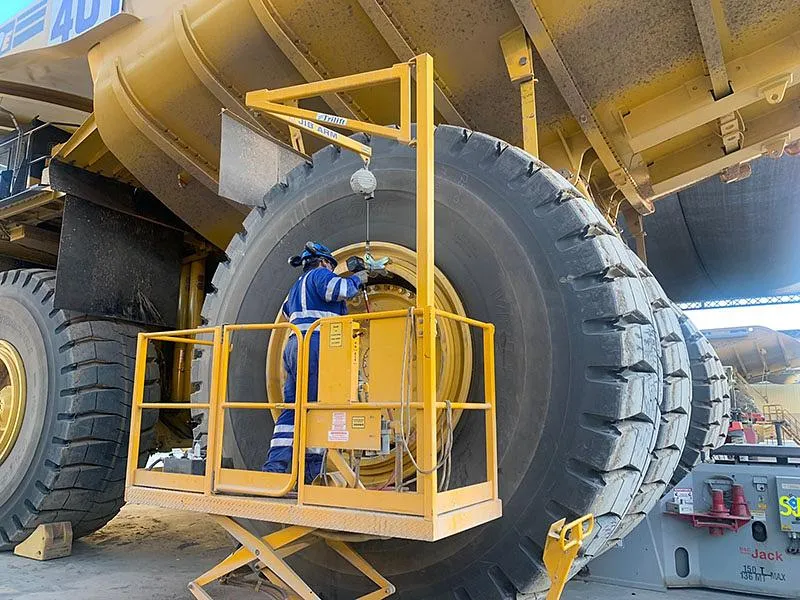(March 22, 2022) Collaborative tire teams at Cerro Verde and El Abra are squeezing thousands of additional miles out of haul truck tires, saving the company money, reducing environmental impact and making them models for the company’s North American sites.
In an effort to continue raising the bar, the operations in Peru and Chile launched separate initiatives several years ago to figure out how to get more miles out of the tires, which cost almost $30,000 each to replace.
Representatives from both operations and maintenance analyzed what was causing tires to wear out and how to extend their life. That collaboration between the people who drive the haul trucks, maintain the roads and fix the tires enabled both sites to extend the average life of haul truck tires by thousands of miles. That saves the company money while reducing waste and carbon emissions associated with disposing of old tires and making new ones.
Setting the standard
“Cerro Verde and El Abra are the leaders in this company when it comes to tire life,” said David Barnes, Superintendent-RAMP. “They’ve got a lot of best practices that we think we can apply all over the place.”
Last year, the company’s Americas’ operations replaced more than 2,300 of the “793” haul truck tires at a cost of about $63 million. The average tire life at the company’s Americas’ operations dropped to 53,948 miles in 2020 from 57,689 miles in 2015.
Cerro Verde and El Abra were notable exceptions. From 2015 to 2020, Cerro Verde extended average tire life to 72,287 miles from 55,630. El Abra went to an average of 65,731 miles from 48,838 miles in that same period.
Key to achieving that success was that both sites created collaborative teams made up of operations and vehicle maintenance workers to analyze why tires were wearing out and how their lives could be extended. They established rigorous maintenance practices for the haul roads and the tires themselves. In essence, they were agile before agile was cool.
At El Abra, tires designed to be heat resistant were phased out and replaced with tires engineered to resist cuts from rocks. In addition to revamping overall maintenance procedures, tire technicians were located at fueling stations to regularly inspect haul truck tires and identify any minor cuts that could fester into big problems. Everyone at the site is encouraged to report any rocks or ruts on the haul roads, and cleanup crews are quickly dispatched to fix them.
“A big change was the tire selection but what accentuated that was the great cooperation between operations and maintenance,” said Luis Mestas Valdivia, Supervisor-Mine Maintenance at Cerro Verde. “Even if one group was doing a great job, if the other group was not, it was useless. Now, with both groups working as one team, that’s making a big change.”
Back to basics
The success at El Abra was similar. It started with a “back to basics” analysis of what was causing tires to wear out, said Anibaldo Aracena Mundaca, Superintendent-Mine Maintenance at El Abra. Everything from tire rotation schedules to the decisions that went into replacing rather than fixing a worn tire was examined. Technicians from the manufacturer were brought in to help ensure the tread pattern on the tires was the most appropriate for the site.
Technical data was used to map problem areas on haul roads, which are rigorously maintained to remove hazards and – where possible – smooth out sharp curves that are particularly hard on the tires.
Haul truck drivers were given field training on the causes of specific types of tire damage – such as small rocks that might create tiny cuts that will worsen over time – and how to avoid them. Tire repair technicians have adopted aggressive maintenance procedures to help ensure even things like small cuts that might have been overlooked in the past are fixed proactively.
Now, the best practices at Cerro Verde and El Abra are being shopped to other sites as the company seeks to extend the average life of haul truck tires by 20 percent across its American operations.
It is important to achieve that goal without sacrificing production, said Craig Willis, Superintendent-Maintenance at Morenci, who leads the MileBusters! agile team created last year to help the company extend tire life.
“Just raising awareness, starting to focus on this problem and communicating it to everybody was one of the biggest things they did at El Abra and Cerro Verde,” Willis said. “That’s one of the things we are driving our teams in North America on now. We need to get everybody aware of the fact that we are struggling with tires.”
A continuation of previous work
The company had a team in North America that met regularly to discuss best practices for extending tire life until about 2010. Maintenance and operations groups within individual sites also have continued working together to examine ways to get more miles out of their tires.
The MileBusters! initiative is an effort to rekindle that more structured collaboration across all sites in the Americas, raise awareness of how important extending tire life is, and focus on figuring out whether innovative practices at one site will work at others.
MileBusters! does not impose the practices that worked in El Abra and Cerro Verde onto the North American sites, Willis said. Rather, it is to encourage them to do the same kind of analysis and creative thinking to tailor their procedures.
Setting a goal to increase life by 20 percent, rather than a specific mileage figure, recognizes each location has its own challenges such as climate, geology and site layout.
“We really want to get buy-in from each site and be driven from within versus from a corporate mandate,” Willis said. “It’s going to be a lot more sustainable if it’s driven from within.”
